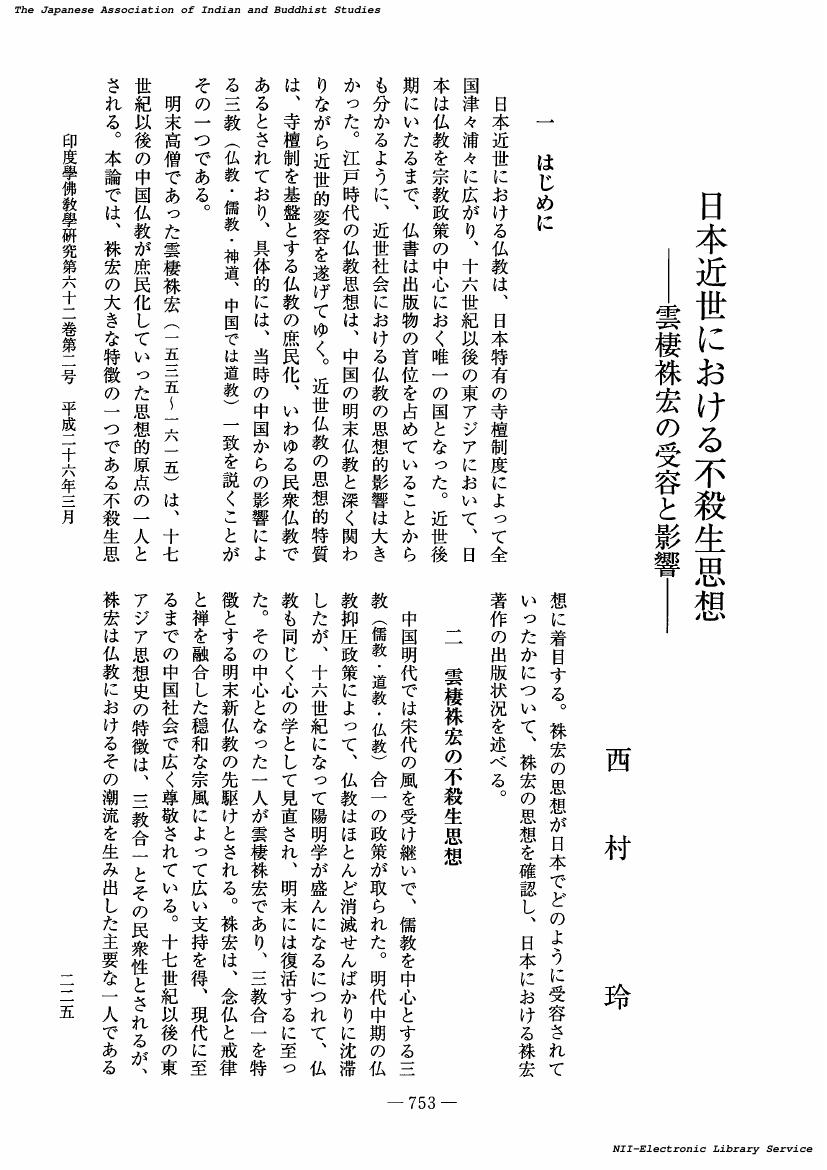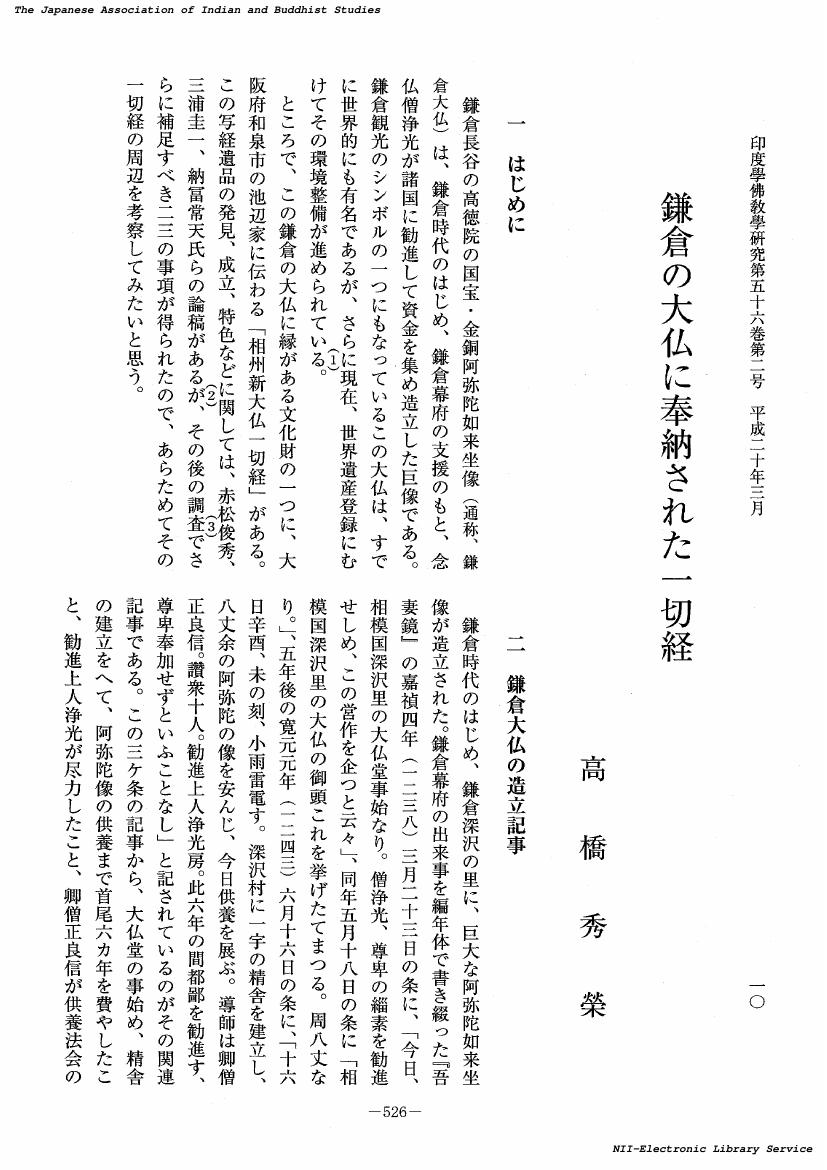2 0 0 0 OA 中国仏教における護国思想の受容過程について
- 著者
- 水野 荘平
- 出版者
- 日本印度学仏教学会
- 雑誌
- 印度學佛教學研究 (ISSN:00194344)
- 巻号頁・発行日
- vol.58, no.1, pp.261-266, 2009-12-20
2 0 0 0 OA 律蔵が禁止する医療行為
- 著者
- 立入 聖堂
- 出版者
- 日本印度学仏教学会
- 雑誌
- 印度學佛教學研究 (ISSN:00194344)
- 巻号頁・発行日
- vol.57, no.2, pp.907-904, 2009-03-20
- 被引用文献数
- 1
2 0 0 0 波羅夷罪の成立史的考察
- 著者
- 佐々木 閑
- 出版者
- 日本印度学仏教学会
- 雑誌
- 印度學佛教學研究 (ISSN:00194344)
- 巻号頁・発行日
- vol.60, no.1, pp.347-339, 2011
2 0 0 0 OA 隋末の「弥勒出世」を標榜した反乱について : 発生時期が意味するもの
- 著者
- 藤井 政彦
- 出版者
- 日本印度学仏教学会
- 雑誌
- 印度學佛教學研究 (ISSN:00194344)
- 巻号頁・発行日
- vol.59, no.2, pp.585-590, 2011-03-20
2 0 0 0 OA ボサツ(仏の前生)から菩薩(菩提を求める有情)へ
- 著者
- 苅谷 定彦
- 出版者
- 日本印度学仏教学会
- 雑誌
- 印度學佛教學研究 (ISSN:00194344)
- 巻号頁・発行日
- vol.54, no.1, pp.348-340, 2005-12-20
2 0 0 0 OA 『續高僧傅』達摩=慧可傅の形成過程について
- 著者
- 伊吹 敦
- 出版者
- 日本印度学仏教学会
- 雑誌
- 印度學佛教學研究 (ISSN:00194344)
- 巻号頁・発行日
- vol.53, no.1, pp.124-130, 2004-12-20
2 0 0 0 OA 禅宗史研究における中国地方志の利用法
- 著者
- 鈴木 哲雄
- 出版者
- 日本印度学仏教学会
- 雑誌
- 印度學佛教學研究 (ISSN:00194344)
- 巻号頁・発行日
- vol.53, no.1, pp.131-136, 2004-12-20
2 0 0 0 雲南の密教と『幻化網タントラ』
- 著者
- 川崎 一洋
- 出版者
- 日本印度学仏教学会
- 雑誌
- 印度學佛教學研究 (ISSN:00194344)
- 巻号頁・発行日
- vol.58, no.1, pp.518-513, 2009
2 0 0 0 OA 中世日本禅宗の逆修とその思想背景
- 著者
- 伊藤 良久
- 出版者
- 日本印度学仏教学会
- 雑誌
- 印度學佛教學研究 (ISSN:00194344)
- 巻号頁・発行日
- vol.57, no.2, pp.687-691, 2009-03-20
2 0 0 0 OA 鈴木正三における死の習練について
- 著者
- 新保 哲
- 出版者
- 日本印度学仏教学会
- 雑誌
- 印度學佛教學研究 (ISSN:00194344)
- 巻号頁・発行日
- vol.57, no.2, pp.696-703, 2009-03-20
2 0 0 0 OA 「顕真実教」の一考察 : 「如是之義」に視点をおいて
- 著者
- 後藤 智道
- 出版者
- 日本印度学仏教学会
- 雑誌
- 印度學佛教學研究 (ISSN:00194344)
- 巻号頁・発行日
- vol.58, no.2, pp.784-787, 2010-03-20
2 0 0 0 OA Prajnaparamitahrdaya(『般若心経』)の問題点 : マントラの解読
- 著者
- 阿 理生
- 出版者
- 日本印度学仏教学会
- 雑誌
- 印度學佛教學研究 (ISSN:00194344)
- 巻号頁・発行日
- vol.56, no.2, pp.875-870, 2008-03-20
2 0 0 0 OA スリランカに知られる投身餓虎本生話と北伝仏教伝承との関係について
- 著者
- 松村 淳子
- 出版者
- 日本印度学仏教学会
- 雑誌
- 印度學佛教學研究 (ISSN:00194344)
- 巻号頁・発行日
- vol.58, no.3, pp.1164-1172, 2010-03-25
餓えた牝虎に自分の身体を与えた物語(投身餓虎,捨身飼虎)は,法隆寺の玉虫厨子に描かれていることでも知られるように,仏教の伝わった地域では広く知られ,数多くの文献資料が遺されている.しかしながら,パーリ語のジャータカ物語にはこの話は含まれず,南方上座仏教国にこの物語が存在することはほとんど知られていなかった.この物語がスリランカにも知られていたことは,法顕の短い記述(『高僧法顯傳』)によりわかるが,そのほかの資料についてはこれまでほとんどわかっていない.ところが,スリランカ仏教徒はパーリ・ジャータカに含まれないジャータカのいくつかを伝承しており,それが近年でも寺院の壁などに描かれている.本論文では同本生話の諸伝承を整理し,それとスリランカで知られる伝承の証拠を絵画および文献資料に求め,それらと北伝伝承との関係を明らかにしようと努めた.なかでも大正No.172経はこれまで具体的に研究されていないが,有名な金光明経の物語より古い,ガンダーラの伝承であることは明らかで,その訳者である法盛も,法顯同様ほぼ同時代にスリランカに旅したであろうことは,南北仏教伝承の交流の具体的事例として,非常に注目すべきことを指摘した.
2 0 0 0 OA 天海版一切経木活字の特色
- 著者
- 水上 文義
- 出版者
- 日本印度学仏教学会
- 雑誌
- 印度學佛教學研究 (ISSN:00194344)
- 巻号頁・発行日
- vol.51, no.1, pp.209-213, 2002-12-20
1 1 0 0 OA 日本近世における不殺生思想 ――雲棲袾宏の受容と影響――
- 著者
- 西村 玲
- 出版者
- 日本印度学仏教学会
- 雑誌
- 印度學佛教學研究 (ISSN:00194344)
- 巻号頁・発行日
- vol.62, no.2, pp.753-757, 2014-03-20 (Released:2017-09-01)
1 0 0 0 OA 覚鑁『五輪九字明秘密釈』における「五臓神形図」の考察
- 著者
- 範 駿
- 出版者
- 日本印度学仏教学会
- 雑誌
- 印度學佛教學研究 (ISSN:00194344)
- 巻号頁・発行日
- vol.69, no.1, pp.282-279, 2020-12-25 (Released:2021-09-06)
- 参考文献数
- 4
A number of studies on Kōgyō Daishi 興教大師 Kakuban’s 覚鑁 (1095–1143) famous work Gorin kuji myō himitsushaku 五輪九字明秘密釈 have been carried out by Seiryu Nasu, Yoshitoyo Yoshioka, Fumio Tanaka and Shunsho Manabe. In these studies, the overall contents of the aforementioned work have been sufficiently discussed. Nevertheless, specialized investigations on the diagram of the ‘Images of Five Visceral Spirits’ (五臓神形図abbreviated as ‘IFVS’) appended to Kakuban’s work remain incomplete, and especially its origin is not clearly known.With regard to IFVS, 4 points have drawn the author’s interest. First, the male figured in the lung god’s image is holding a spear. Second, a boy and girl are figured in the liver god’s image. Third, the jade lady figured in the heart god’s image is holding a jewelled vase. Fourth, the gesture of the spiritual beast figured as the kidney god.In this paper, the origin of IFVS, with focus on the above four points, will be discussed by examining materials found in a Tang period Taoist text called the Chart on the Procedures for Filling and Emptying the Six Receptacles and Five Viscera according to the Inner Landscape of the Yellow Court (Huangting neijing wuzang liufu buxie tu黄庭內景五臟六腑補瀉圖) by the priestess Hu Yin胡愔 (fl. 848).
1 0 0 0 OA Putrākhyā Daśa Pañca Ca
- 著者
- 谷口 力光
- 出版者
- 日本印度学仏教学会
- 雑誌
- 印度學佛教學研究 (ISSN:00194344)
- 巻号頁・発行日
- vol.71, no.3, pp.943-947, 2023-03-25 (Released:2023-09-08)
- 参考文献数
- 8
家産分割,相続の主体となる様々な「息子」は12世紀頃以降においていかにカテゴライズされ,相対的に位置づけられたか.本報告は,Vijñāneśvara著Mitākṣarā(ca. 1056-1126),Haradattamiśra著Ujjvalā(ca. 1100-1300)という2作品のdharmanibandhaが伝える息子論(eg., putraprakaraṇa)から,このような議論が精緻化してゆく様相の一端を跡付ける. putraprakaraṇaは,主要な息子とされる嫡出子(aurasa)と,養子(dattaka)や再婚女性の息子(paunarbhava)などとの相続上の関係性について情報を伝える.中世サンスクリット法律学における法益論や近現代南アジアにおける寡婦再婚問題などにも関連する重要主題の一つである. 主たる初期文献群(dharmasūtra, dharmaśāstra)は,微妙な相違はあるものの,一般に息子として12-13種類を数える.しかし,その数はMitākṣarāでは14種類,さらにUjjvalāでは15種類に至る.既往研究では,このような息子に関する議論について,諸資料に見られる相違点は「なにか」という点での貢献が行われてきた.本稿は,それらの相違点が「どのように」生じるのかに焦点を当てる. 具体的には,Mitākṣarā,Ujjvalāに見られる発達した議論の間にある唯一の相違点である “yatra kvacanotpādita”と呼ばれる息子種について,これがなぜ前者では言及されず,後者では第15位の息子として掲げられるようになったのかについて,その学的背景を探る.そして,これら両資料が想定していたであろう「結婚の正当性」との関係から,この差異を説明可能であることなどを指摘する. 南アジア広域で指導的地歩を築いたMitākṣarāと,最多の息子種を数えるらしいUjjvalāとの差異化の一端が示されることで,それ以降に著されたdharmanibandhaなどとの比較を行う上での基盤が得られたと期待する.
1 0 0 0 OA 法天訳『最上大乘金剛大教寶王經』と『秘密集会タントラ』聖者流
- 著者
- 苫米地 等流
- 出版者
- 日本印度学仏教学会
- 雑誌
- 印度學佛教學研究 (ISSN:00194344)
- 巻号頁・発行日
- vol.61, no.1, pp.406-401, 2012-12-20 (Released:2017-09-01)
1 0 0 0 OA 鎌倉の大仏に奉納された一切経
- 著者
- 高橋 秀榮
- 出版者
- 日本印度学仏教学会
- 雑誌
- 印度學佛教學研究 (ISSN:00194344)
- 巻号頁・発行日
- vol.56, no.2, pp.526-533, 2008-03-20 (Released:2017-09-01)
1 0 0 0 OA 広蔵院日辰の本迹論に関する一考察――序品題号の「妙法」をめぐって――
- 著者
- 神田 大輝
- 出版者
- 日本印度学仏教学会
- 雑誌
- 印度學佛教學研究 (ISSN:00194344)
- 巻号頁・発行日
- vol.68, no.2, pp.670-675, 2020-03-20 (Released:2020-09-10)
- 参考文献数
- 3
In relation to the various religious doctrines which became diversified after the death of Nichiren (日蓮), the viewpoint of Honjaku theory (本迹論) is the most important index to examine the characteristics of the disciples. Kōzōin Nisshin (広蔵院日辰, mid-16th c.), who was based in Kyoto during the Sengoku Period, was a notable learned priest who established a major theoretical system of the Honjaku theory. Nisshin discriminated between Honmon (本門) and Shakumon (迹門). The distinctive feature of the theory is that it discusses the superiority of “Chapter 16, Nyorai Juryō-hon (如来寿量品第十六)” out of the 28 chapters of the Lotus Sūtra. In this paper, in order to clarify the characteristics of the Honjaku theory of Nisshin, I compare it with the theory of the Icchi school (一致派) priests who discussed the unity of the Honmon and Shakumon. I took up as my starting point the contention shared by the learned priests of the Shoretsu (勝劣) and Icchi schools, that is, the interpretation of “Myōhō 妙法” in the first introductory chapter. The teachings of the abovementioned priests strongly reflect the characteristics of the doctrines that they upheld. Here I point out that Nisshin interprets this “Myōhō” of the title of the introductory chapter based on the sixteenth chapter.














